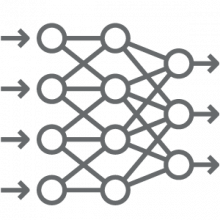Research Directions and Interests

Evolutionary Computation
The development of algorithms inspired by biological evolution to solve computational problems

Optimization
The study of methods to optimize the performance of machine learning models

Active Learning
Prioritizing data labelling to optimize the training of supervised models

Deep Learning
Algorithms inspired by the structure and function of the brain referred to as artificial neural networks

Reinforcement Learning
Enabling an agent to learn by trial and error using feedback from actions and experiences

Natural Language
A field that gives machines the ability to read, understand and derive meaning from human language

Time Series
The use of machine learning methods in a manner that seeks to predict future value

Graphics & Visualization
Generating graphics with the aid of machine learning
Techniques and Models
Artificial Intelligence
- Supervised Learning
- Unsupervised Learning
- Transfer Learning
Deep Learning Models
- Neural Network (MLP, FLNN, SONIA, ELM, RBFN, CFNN, ANFIS, Hopfield)
- Deep Neural Network (DNN, CFNN)
- Recurrent-based Network (RNN, GRU, LSTM, CNN)
Optimization Branches
- Meta-heuristic Algorithms (Approximation algorithms, Nature-inspired computing, soft-computing)
- Multi-objective Optimization
- Convex programming (Linear programming)
- Combinatorial Optimization
- Robust Optimization
Natural Language Processing
- Word Segmentation
- Part-of-speech tagging
- Stemming and Parsing
- Named entity recognition
- Sentiment analysis
Applications
- Benchmark functions optimization
- Engineering applications
- Log template generation for large-scale system
- Resources consumption management (decision making system)
- Time-series prediction (i.e, hydrology related such as inflow, streamflow, groundwater level forecasting)









